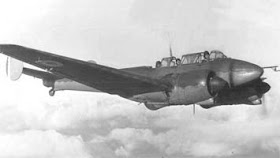Caza nocturno Potez 631
En muchos aspectos el caza nocturno Potez 631 se parece al Bristol Blenheim de la RAF, muy similar en tamaño y prestaciones que además fueron concebidos también para el bombardeo ligero. El prototipo para caza nocturno voló por primera vez en 1937 bajo la designación de Potez 631-0 aunque no despertó gran entusiasmo entre las autoridades militares francesas y su inmovilismo político. No fue hasta junio de 1938 cuando se emitió la primera orden para la producción de este caza nocturno fabricándose un total de 207 aparatos.
El 1 de abril de 1939 el Armée de l'Air había recibido 88 aviones de este tipo de los cuales solo 20 estaban en servicio. Para el mes de mayo los Groupes de Chasse de Nuit GCN III/l y II/4 más el CG II/8, fueron equipados con unos 30 cazas de este tipo mientras que en Yibuti se desplegaron otros cuatro aparatos más. Cuando estallaron las hostilidades habían sido entregados 206 aparatos de este tipo sumándose al GCN 1/13 y GCN 11/13 así como a 7 escuadrones de caza. Algunos de estos aparatos serían trasladados posteriormente a la Aeronavale.
Cuando los alemanes lanzaron su ofensiva sobre el oeste varias unidades de Potez 631, tanto de caza diurna como nocturna, se encontraban en acción aunque la falta de radares impidieron más éxitos durante las acciones nocturnas. En los primeros 11 días de lucha la Flotille Aeronavale F habían derribado 12 aparatos alemanes a cambio de 8 propios pero pronto recibieron órdenes de abandonar la lucha nocturna para sumar sus esfuerzos en ataques diurnos a tierra dónde sufrieron fuertes pérdidas por el fuego antiaéreo alemán.
Otras pérdidas se sufrieron debido a la similitud del Potez 631 con el Messerschmitt Bf 110 alemán siendo objetivo del fuego antiaéreo amigo, se estima que hasta el 30% de los aviones franceses habían sido derribados por error. En total los cazas nocturnos Potez 631 derribaron 29 aparatos alemanes durante la batalla de Francia pero a costa de perder 93 aviones propios. Del resto, unos 110 se encontraban en la zona de la Francia libre en el momento del armisticio pero su número se redujo rápidamente a causa de la crónica falta de repuestos y del traslado del REC 3/13 a Túnez en junio de 1941.
Fuentes:
BREFFROT, D. “French Aircraft from 1939 to 1942, Vol.2: from Dewoitine to Potez” Histoire & Collections, 2005
BRINDLEY, J. “French Fighters of World War Two” Lacy Publishers Ltd., 1971
JACKSON, R. “Air War over France 1939-40”
MARCHAND, P. “Les Potez 63, Les Ailes de Gloire No.9” Editions d'Along, 2003
EHREMGART, C. “Le Potez 63 et dérivés” Aéro-Editions, November 2005
PELLETIER, A. “ French Fighters of World War II.” Squadron/Signal, 2002
English version
In many respects the Potez 631 night fighter resembles the RAF Bristol Blenheim, very similar in size and performance were also designed also for light bombing. The night fighter prototype first flew in 1937 under the designation Potez 631-0 but not aroused much enthusiasm among the French military authorities and political stagnation. It was not until June 1938 when it issued the first order for the production of this night fighter being manufactured a total of 207 devices.
On April 1, 1939 the Armee de l'Air had received 88 aircraft of this type of which only 20 were in service. For the month of May Groupes de Chasse de Nuit GCN III/l and II/4 plus the GC II/8, were equipped with about 30 fighters of this type while in Djibouti were deployed four more devices. When hostilities broke out had been handed over 206 aircraft of this type joining the GCN 1/13 and GCN 11/13 to 7 and fighter squadrons. Some of these devices would be subsequently transferred to the Aeronavale.
When the Germans launched their offensive on the west several units of Potez 631, hunting both day and night, were in action but the lack of radar prevented more success during the night actions. In the first 11 days of fighting the F Aeronavale Flotille had shot down 12 aircraft in exchange for 8 Germans themselves but soon received orders to leave the fight night to add their efforts to land where daytime attacks suffered heavy losses by German flak.
Other losses were suffered due to the similarity of the Potez 631 with the German Messerschmitt Bf 110 to be targets of flak friend, it is estimated that up to 30% of French planes had been shot down by mistake. In total Potez 631 night fighters shot down 29 German units during the Battle of France but at the cost of losing 93 aircraft themselves. Of the remainder, about 110 were in the area of the Free French at the time of the armistice but their numbers declined rapidly because of the chronic lack of spare parts and the transfer of REC 3/13 to Tunisia in June 1941.
Potez 631 C3 ECN I/13
Sources:
BREFFROT, D. “French Aircraft from 1939 to 1942, Vol.2: from Dewoitine to Potez” Histoire & Collections, 2005
BRINDLEY, J. “French Fighters of World War Two” Lacy Publishers Ltd., 1971
JACKSON, R. “Air War over France 1939-40”
MARCHAND, P. “Les Potez 63, Les Ailes de Gloire No.9” Editions d'Along, 2003
EHREMGART, C. “Le Potez 63 et dérivés” Aéro-Editions, November 2005
PELLETIER, A. “ French Fighters of World War II.” Squadron/Signal, 2002




No hay comentarios:
Publicar un comentario